|
|
|
|
|
OF CHRISTIANITY |

A COMPREHENSIVE LISTING WITH
PROFILES
COMPLIED & EDITED BY

RAKA
PUBLICATIONS
UNITED
KINGDOM
TWO
EDITIONS: 1996/1997
The motive of this work is to expose overwhelming evidence of the immense contribution over many centuries by children of AFRIKA (NUBALLA) indigenous and abroad, to the now diluted western religious persuasion: CHRISTIANITY whether Orthodox or Un-Orthodox. I am of the sincere opinion that these facts were heretofore unavailable to the average reader.
In no way do I seek to quantify nor defend the diverse concepts of this dogma. It is my deepest wish that all readers, regardless of their ethnic origin, may be inspired by this offering. Let the numerous myths perpetrated over the centuries be finally put to rest.
For the children of NUBALLA did govern early Christian Empires with Monotheistic conviction. While in the latter times, they did substantially conduce to the now prevalent conviction of Jesus Christ as an integral part of the “HOLY TRINITY” during and after the phenomena of ANTIOCH.
I refrained from using the description ‘BLACK’ in an effort to avoid the negative connotations this word has represented over the centuries, and today especially in English Language. Even the antagonist and sometimes agonizing debate of a NUBIAN MADONNA or the racial identity of her revered son, has been purposely omitted since it is not relevant to the quest of this journey.
However the undisputed antiquities of Alexandria, Theban Delta, Carthage, Numidia, Soba, Axum, Nobadia, Alodia and Muqqurra on the continent of NUBALLA dwarfing Rome and Constantinople could not be resisted. Nor the everlasting impact of legends that feature ZEUS, LILLITH, ISIS, HERMES and SIBYL excluded.
The theme of this work was inspired by the miraculous surviving influence of Saints MAURICE, AUGUSTINE, GREGORY, KATHERINE, THOMAS, VICTOR, BENEDICT, ANTHONY, MENAS, MONICA, ALODIA, THEODORA and ADDAI amongst others. This is the wilful, but well -meaning focus of this publication. In addition I have include other Christians who have had great impact on this faith.
May it evoke euphoria or even nostalgia for the good old days by the starved multitudes of modern day adherents of Christianity. I reiterate that I do not seek to dispute nor promote any particular sect of Christianity. Yet Saints are an intriguing group of men, women and children of all races (powerful, powerless, inept, articulate and disabled) who through their dedication, suffered, and in many instances gave their lives in exchange for the perpetuation of a doctrine. While, the worship of saints is a concept of ancestral worship that has always been an integral part of Afrikan culture.
Though many of the alleged miracles and sacrifices seem incredible to us today, the purpose of this work is not to judge these individuals but rather expose their lineage. For while I cannot pretend to be a supporter of the criteria utilized by various CHURCHES to deify / canonize these adherents, its useful to note that many have been purposely omitted from religious calendars. As a subscriber to the study of COMPARATIVE RELIGION with its’ anthropological link, I am therefore bounded to narrate the contributions of the Nubian Saints of Christianity.
This work is but a celebration of endurance and persistent faith as displayed
by many across the globe. Those who despite varying acute conditions
(especially non sympathetic political systems of the Right, Moderate and
Left) have triumphed with resistance and glory -a dignity non solvent unto
this day.
ROI ANKHKARA GUNAPO KWABENA
|
OF 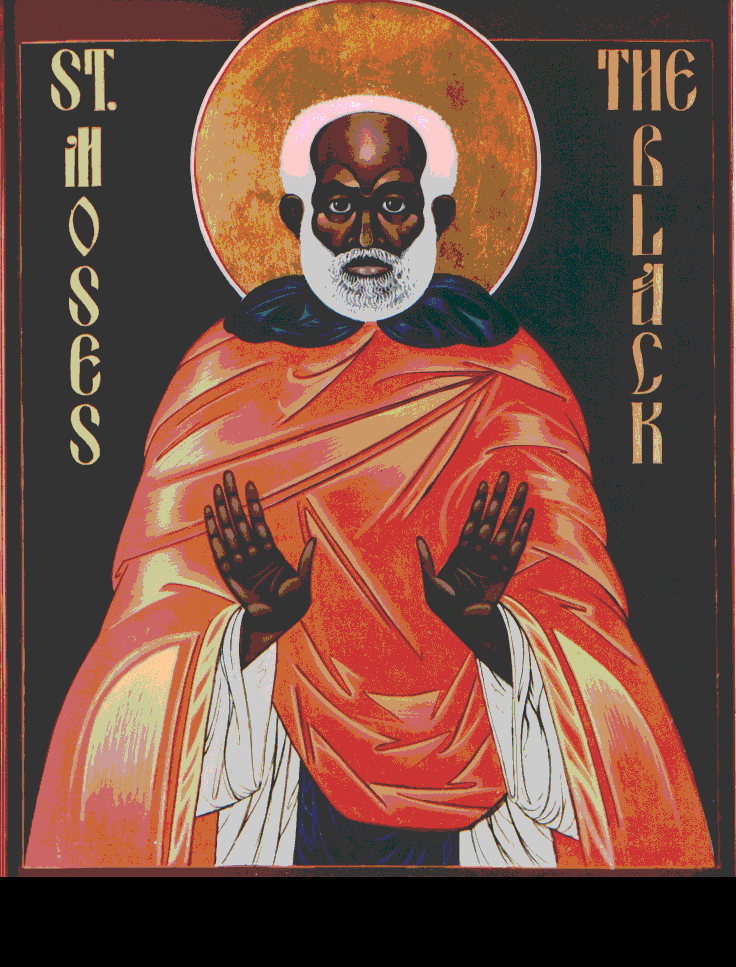 |

A celebrated personality in Europe since the
Third Century of the Christian era. He was born a Theban (Nubian) in Upper
Egypt / Sudan. Yet though Christianity was flourishing in this region,
it was under the control of the Roman Empire as other lands in the vicinity
of the Mediterranean Sea.
St. Maurice, was the leader of the Roman legion of the district. In autumn
of 285 C.E., Emperor Maximilian sent a large army to Switzerland to oppose
a rebellion in the south of Galla. These forces included the
Theban Legion.
St. Maurice was assigned to Agaunium, 20 Kilometers from the Genfer Lakes.
At a large field service before the battle, the soldiers were required
to worship icons of pagan gods which included a statue of the emperor.
The entire legion refused. This was considered an act of rebellion
and blasphemy. They were
charged
with high treason and mutiny before the
enemy. The result was the beheading of Maurice and his companions.
From then, Christians cherished and adored Maurice
as a martyr. Within a century of his passing, he
was beatified and a church was constructed over his tomb. The
Swiss national flag bears a white cross in
his honour. Over the ages the cult
of Maurice spread over Germany where he became
the official Saint Knight of
the Emperors and Bishops who sought his miracles
and blessings. Coins and Coats of Arms for many districts
and cities in Germany were made in his honour. He is still
worshipped in Poland, Romania, Switzerland, Austria,
Greece, Italy, Czechoslovakia, Hungary, Britain,
Germany & the former states of Yugoslavia, where his
iconography decorates churches and shrines.
His feast days are :- February
25th; June 3rd; September 11th, 22nd, & 28th; October
11th, 16th & 19th.
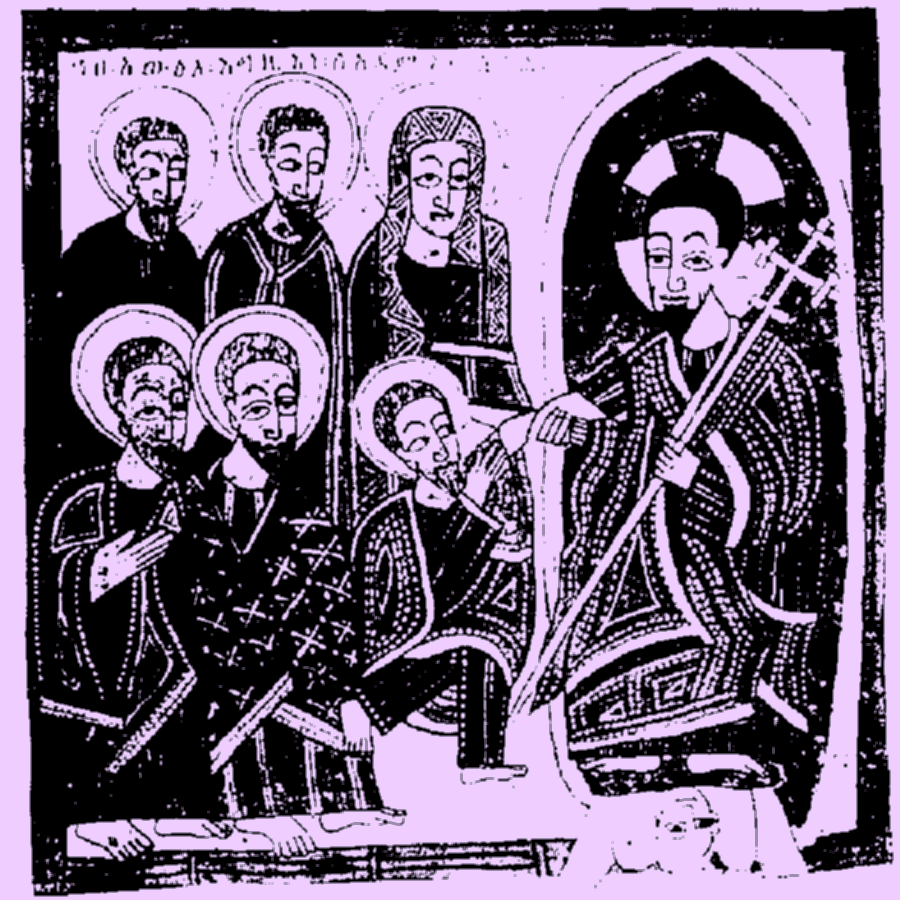
The
legacy of scriptural literature by early Nubians is not well
known to many who preach and profess to practice Christianity.
If anything, the crucial evidence is suppressed by the powers that
be, hidden away in the vaults of numerous academic and religious
libraries / museums across Europe ( East & West ).
Nevertheless these priceless documents provide distinct proof of
the invaluable contributions made by Nubian Christians
over the centuries. These works have provided the basis for
the way of life of the faithful from the earliest times unto present day.
It is unfortunate that not enough is being done currently to
promote this knowledge by way of research
and dissemination.
There is much scope for study of the many
thousand manuscripts (Ecclesiastical and literary)
from the Nubian Christian Epoch.
However these should not be isolated
from similar works of other Nubian theologians who were
based in Constantinople, Spain, Germany,
Switzerland, Italy, Malta, Palestine, Arabia, Turkey, Iraq
and Asia. The relatively peaceful contact
and co-existence of these Monophysitic
Christians with the Islaamic
World is another subject worth examination.
The case is that many
of these manuscripts were
preserved in
Arabic before translation to Amharic
(aka AMHARIGNA,
a Semitic language which along
with the Tigrigna tongue both
descended from Ge’ez
the ancient lingua of Axum) . Actually
tolerance of religious persuasions with attendant
diversity is vital
in the pursuit of knowledge.
Reproduced here are distinctive
examples of these ancient
texts, albeit purposely secreted away.
My original intention was to
include as many examples of these works.
However owing to the
size of this publication, only
a sampling of small extracts are
included.

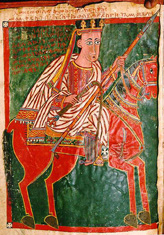
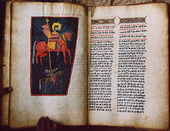
Among the many worthy pristine references excluded are:
*
GOSPEL BOOK (ABBA GUERIMA)
* PRAISE YE WITH ORGAN ( ELLENI )
* RAYS OF THE SUN ( ELLENI )
* DEGOUA- FEAST DAYS OF THE YEAR ( YARED )
* BOOK OF JUBILEES
* ASCENSION OF ISIAH
* A SHEPERD (HERMAS)
* APOCALYPSE OF ESDRAS
* THE GARDEN (GANNAT)
*
MASHAFA BERHAN ( Book of the Light )
* HISTORIES OF THE HOLY FATHERS
* GARDEN OF THE MONKS
*
ROYAL GENEALOGIES
(
NEBOURE ID GUEBRE SELLASSIE )
Further research may be conducted by the reader merely
by consulting the bibliography provided. It was indeed a difficult
task to exclude vast amounts of pertinent material made available to me
over a decade of research that led me to institutions on
the motherland, Nuballa ( Ethiopia / Egypt / Sudan )
and across Europe.
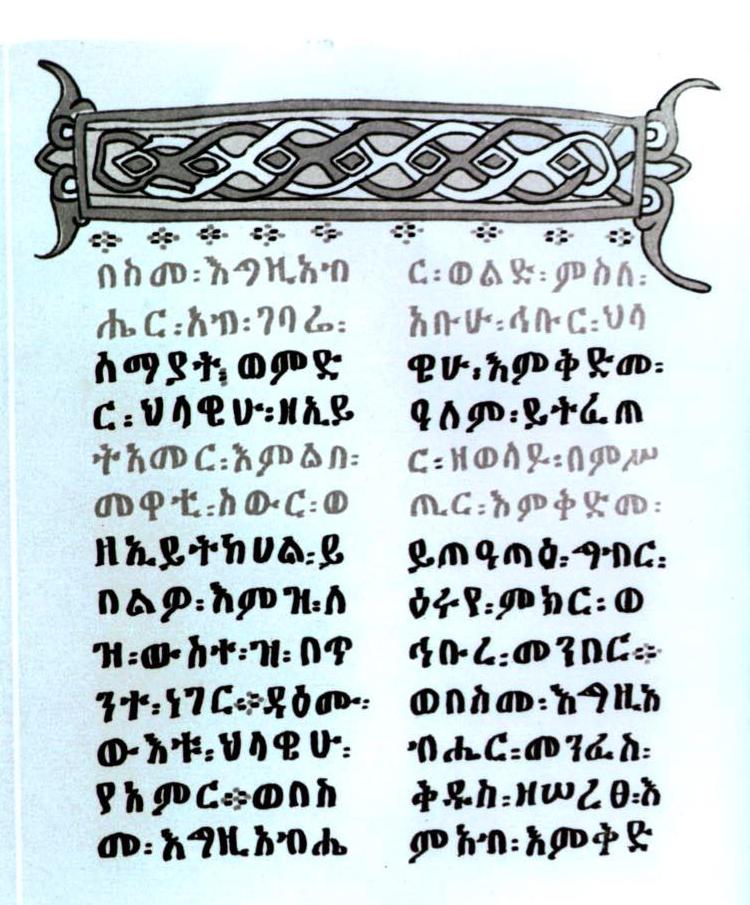
BOOK OF THE SAINTS OF ETHIOPIA CHURCH
This unique work of over five large volumes contains the histories of Angels
and Archangels and their relationship to humanity. It is an impressive
collection of accurate narration of lives led by the Patriarchs, Prophets,
Apostles, archbishops, Bishops, Anchorites, Coenobites in addition to the
lesser known and fabled Ascetics who roamed the deserts of Egypt,Sudan,
Libya, and Ethiopia. These records were translated into Ethiopic
(GE’EZ ) from the Arabic in which it was preserved. The Arabic versions
were made from the Coptic work: LIVES OF
THE SAINTS. Examples of this masterpiece
are available in Latin, Greek, and Syriac.
Most of the saints recorded were martyrs. It is also worthy to note
that the compilers of these records, had intimate knowledge of the monastic
lifestyles led by many in the Thebaid, Aswan and Lower Egypt. This
book of saints can be rightly referred to as 'The
Book of Martyrs’. The authors were Bishops
Abba Mikael and A'bba John who had many dedicated research assistants in
the persons of several priests.
The MASHAFA SENKESAR is
dated to the early Tenth Century of the Christian Era. It is a daily record,
according to the Ethiopian Calendar of the
Martyrs with an in-depth analysis of their
contributions. Examples of the conflicts of Racism and the Monotheistic
concept versus the Trinity are highlighted. This is another valuable resource,
deserving of more exposure.
ETHIOPIAN MONASTERIES
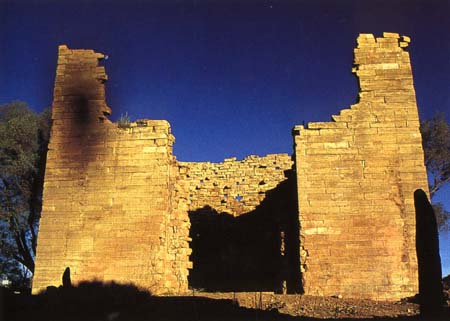
Here is
listing of Ethiopian Monasteries
(though not a totally comprehensive
one)
* Abba Garima *Asatan Maryam
*Dabra Bizan-
*Dabra Maryam *Gunda Gunde
* Haiq
*Kebran * Lalibala * Ura
*Kidana Mehrat *Zeway

BANDLET OF RIGHTEOUSNESS
The most fascinating collection of sacred texts is without doubt the‘BANDLET
OF RIGHTEOUSNESS’. Among the contents
is the awe-inspiring 'SCROLLS OF LIFE'
(MASHAFA
HAYWAT ) in Ethiopic
and the 'MYSTICAL
NAMES OF THE PERSONS OF THE TRINITY’ (
TERGUAME
FIDAL ) in Amharic.
European Archaeologists in their disturbance of sites of antiquity
in Ethiopia and Sudan discovered numerous strips of parchment. Some of
these strips were wrapped around the bodies of the deceased. These
were confiscated under the guise of research and preservation by these
plunderers.
It is an established fact that early burials in Nuballa
were
originally made in coffins made of reed. Bandages of parchments
were used to wrap the dead as part of an ancient tradition linked to the
belief that they will assist the wearer to come forth on the day of Judgement.
Parchments were also used as amulets. Upon which were inscribed spells,
mystical symbols, crosses and figurines to ward off disease and sickness
in men and children. It was used by women as protection, especially
for miscarriages/abortions caused by evil spirits and ensure safe delivery.
Those accused for the illegal removal / theft of these sacred items
are now also accountable for mis-guidance. They even
erroneously suggested that the stolen loot of parchments, now located in
many inaccessible vaults of several libraries, museums, and universities
constitute the famed 'LAFAFA SEDEK’.
However these hold very little in common with the authentic ‘Scroll
of Life’,
which has the claim of being written by the hands of the Creator. It was
conceived to protect the deceased from mutilation in the grave and the
awful fire in Hell. This scroll serves as a key to attain everlasting life
in paradise.
This fact links it directly with the '
PERT EM HRU ’ . This is also known as
the ‘Egyptian Book of the Dead’ of which the best preserved copy
is the ‘PAPYRUS
OF ANI’ and dates to the Eighteenth
Dynasty of Kushite regents ( 1575 B.C.E.)in
TA
MERI. While othercopies date from as early
as the Fifth Dynasty.
The ancestors of the Christians of Sudan and Ethiopia were the ones
who established an ancient culture which eventually exported civilization
to the north (i.e. TAMERI/ KMT
) since 3500 B.C.E. This was done under the leadership of a regent
known only by the name ‘SCORPION’.
Throughout succeeding dynasties of regents, the worship of Deities
such as OSIRIS, ISIS , Horus ( representing DEATH, Motherhood and the Resurrection)
and THEHUTI 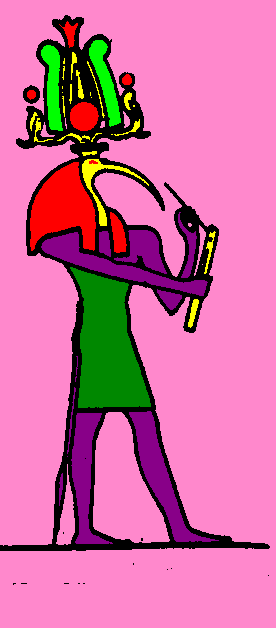 (
aka THOTH: the author of spells & prayers) were established. For it
is common knowledge that Greek scholars studied the HERMITICA:teachings
of the deity THOTH. Clearly this indicates an irrefutable connection to
the concepts adhered to by Christianity.
(
aka THOTH: the author of spells & prayers) were established. For it
is common knowledge that Greek scholars studied the HERMITICA:teachings
of the deity THOTH. Clearly this indicates an irrefutable connection to
the concepts adhered to by Christianity.
The Egyptian Book of the Dead
also promoted the belief that it's
spells would preserve the dead, procuring for their souls everlasting life,
complete with comfort and happiness in the afterlife.
Many of the latter day construction of pyramids and temples after the Twenty
Fifth Dynasty were in Meroe,
Napata
and
Semna
in
Sudan. The walls of these monuments like their counterparts in Egypt, are
adorned with reliefs of vignettes from the
'Saite Recession' of the 'Papyrus
of Ani'.
It is also recorded that a king of the Axum empire imported to his region
a black stone from Kush. This relic was found in 1771
C.E.. Upon which was inscribed an illustration
of the Nubian deity HERU
(HORUS) on one side and the other with magical spells in Kushite
Hieroglyphs.
The religion of Christianity from its origin adopted many of the same ancient
concepts of Kush. AUSAR
( OSIRIS ) represents Jesus, with AUSET
( ISIS )as his mother and Horus as the reincarnation/ resurrection.
The Osiris legend has many inferences that have been inadvertently
repeated in the Bible. For example the thirteen pieces into whichOsiris
was cut and the thirteen pieces of silver in the episode of Jesus'
persecution.
The name ‘BANDLET OF RIGHTEOUSNESS’was
derived from the name‘LAFAFA SEDEK’.
SEDEK:TRUTH/
JUSTICE / RIGHTEOUSNESS
LAFAFA:
SHROUD
/ WRAPPING / TO ENVELOPE / TO TIE
The word SEDEK survives
in the Arabic language as SAADIQ,
with the same meaning. While in the era of Ta-Nuhusi and TAMERI the
same meaning was ascribed to the prominent female deity of the regents
known as - MA’AT.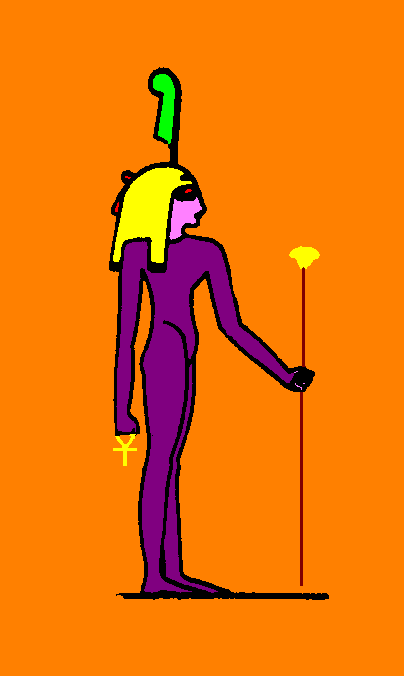
The LAFAFA
SEDEK has
its origin in the suggestion that JESUS the Christ appeared to his mother
MARYAM and conducted her on a tour through HEAVEN and HELL. The seal
of Solomon is inscribed all over the document. This symbol was reported
to have been bestowed as a gift to Makeda (Queen of Sheba) who passed iton
to her son Menyelek.
The words- ‘It guideth to Righteousness’
is written after every spell.

|
|
TEMPLE OF ANKHKARA |

WEB DESIGN BY
ANKHKARA